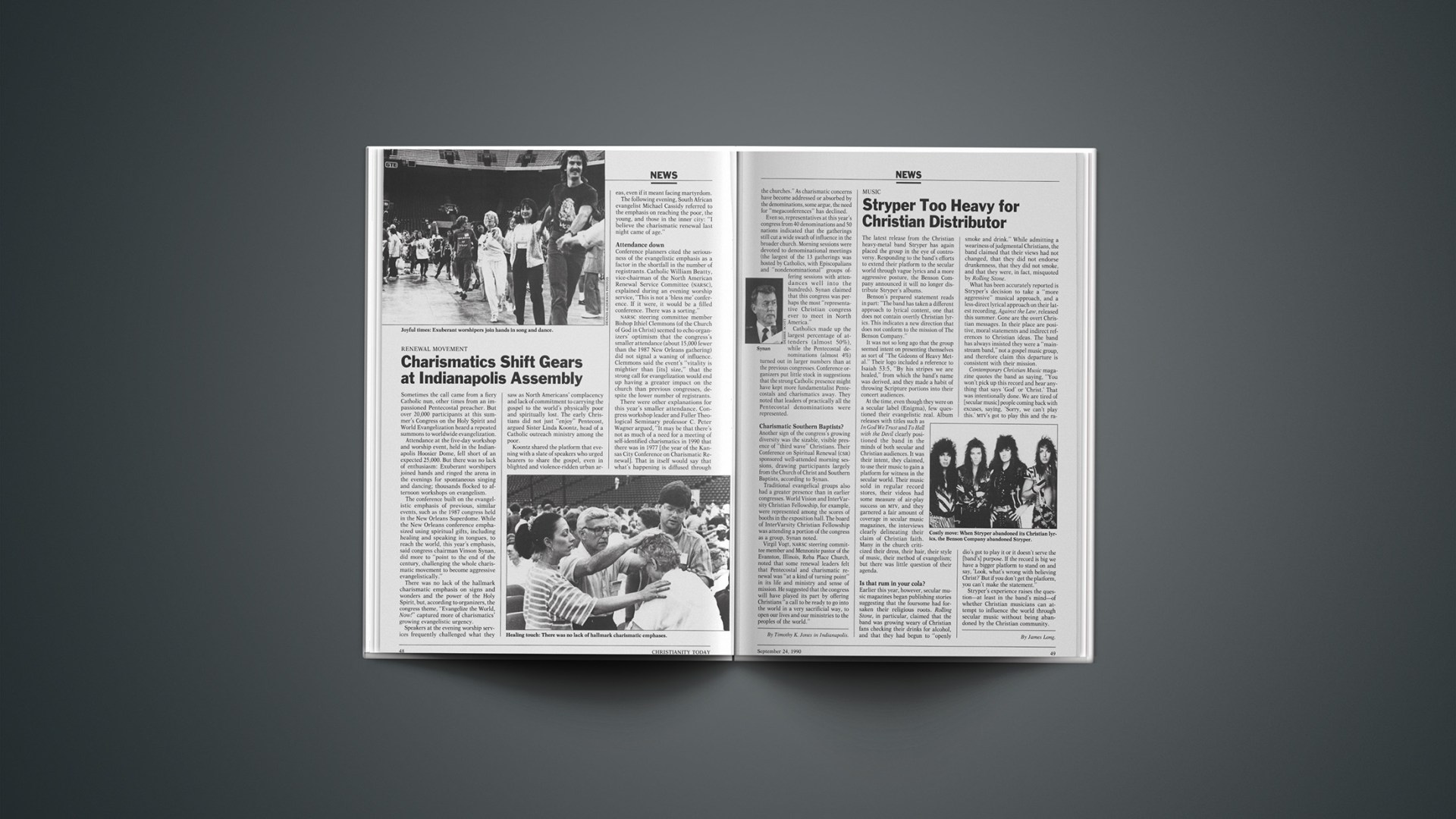Sometimes the call came from a fiery Catholic nun, other times from an impassioned Pentecostal preacher. But over 20,000 participants at this summer’s Congress on the Holy Spirit and World Evangelization heard a repeated summons to worldwide evangelization.
Attendance at the five-day workshop and worship event, held in the Indianapolis Hoosier Dome, fell short of an expected 25,000. But there was no lack of enthusiasm: Exuberant worshipers joined hands and ringed the arena in the evenings for spontaneous singing and dancing; thousands flocked to afternoon workshops on evangelism.
The conference built on the evangelistic emphasis of previous, similar events, such as the 1987 congress held in the New Orleans Superdome. While the New Orleans conference emphasized using spiritual gifts, including healing and speaking in tongues, to reach the world, this year’s emphasis, said congress chairman Vinson Synan, did more to “point to the end of the century, challenging the whole charismatic movement to become aggressive evangelistically.”
There was no lack of the hallmark charismatic emphasis on signs and wonders and the power of the Holy Spirit, but, according to organizers, the congress theme, “Evangelize the World, Now!” captured more of charismatics’ growing evangelistic urgency.
Speakers at the evening worship services frequently challenged what they saw as North Americans’ complacency and lack of commitment to carrying the gospel to the world’s physically poor and spiritually lost. The early Christians did not just “enjoy” Pentecost, argued Sister Linda Koontz, head of a Catholic outreach ministry among the poor.
Koontz shared the platform that evening with a slate of speakers who urged hearers to share the gospel, even in blighted and violence-ridden urban areas, even if it meant facing martyrdom.
The following evening, South African evangelist Michael Cassidy referred to the emphasis on reaching the poor, the young, and those in the inner city: “I believe the charismatic renewal last night came of age.”
Attendance Down
Conference planners cited the seriousness of the evangelistic emphasis as a factor in the shortfall in the number of registrants. Catholic William Beatty, vice-chairman of the North American Renewal Service Committee (NARSC), explained during an evening worship service, “This is not a ‘bless me’ conference. If it were, it would be a filled conference. There was a sorting.”
NARSC steering committee member Bishop Ithiel Clemmons (of the Church of God in Christ) seemed to echo organizers’ optimism that the congress’s smaller attendance (about 15,000 fewer than the 1987 New Orleans gathering) did not signal a waning of influence. Clemmons said the event’s “vitality is mightier than [its] size,” that the strong call for evangelization would end up having a greater impact on the church than previous congresses, despite the lower number of registrants.
There were other explanations for this year’s smaller attendance. Congress workshop leader and Fuller Theological Seminary professor C. Peter Wagner argued, “It may be that there’s not as much of a need for a meeting of self-identified charismatics in 1990 that there was in 1977 [the year of the Kansas City Conference on Charismatic Renewal]. That in itself would say that what’s happening is diffused through the churches.” As charismatic concerns have become addressed or absorbed by the denominations, some argue, the need for “megaconferences” has declined.
Even so, representatives at this year’s congress from 40 denominations and 50 nations indicated that the gatherings still cut a wide swath of influence in the broader church. Morning sessions were devoted to denominational meetings (the largest of the 13 gatherings was hosted by Catholics, with Episcopalians and “nondenominational” groups offering sessions with attendances well into the hundreds). Synan claimed that this congress was perhaps the most “representative Christian congress ever to meet in North America.”
Catholics made up the largest percentage of attenders (almost 50%), while the Pentecostal denominations (almost 4%) turned out in larger numbers than at the previous congresses. Conference organizers put little stock in suggestions that the strong Catholic presence might have kept more fundamentalist Pentecostals and charismatics away. They noted that leaders of practically all the Pentecostal denominations were represented.
Charismatic Southern Baptists?
Another sign of the congress’s growing diversity was the sizable, visible presence of “third wave” Christians. Their Conference on Spiritual Renewal (CSR) sponsored well-attended morning sessions, drawing participants largely from the Church of Christ and Southern Baptists, according to Synan.
Traditional evangelical groups also had a greater presence than in earlier congresses. World Vision and InterVarsity Christian Fellowship, for example, were represented among the scores of booths in the exposition hall. The board of InterVarsity Christian Fellowship was attending a portion of the congress as a group, Synan noted.
Virgil Vogt, NARSC steering committee member and Mennonite pastor of the Evanston, Illinois, Reba Place Church, noted that some renewal leaders felt that Pentecostal and charismatic renewal was “at a kind of turning point” in its life and ministry and sense of mission. He suggested that the congress will have played its part by offering Christians “a call to be ready to go into the world in a very sacrificial way, to open our lives and our ministries to the peoples of the world.”










